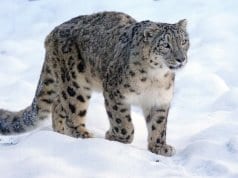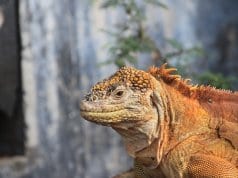Iguazu National Park is a 261-square-mile protected area, located in northeast Argentina. The park is likely most famous for its namesake river and waterfall (which is the largest waterfall system in the world), but it is also home to a variety of fascinating and beautiful animal species. The park is located in the Alto Paraná Atlantic forests ecoregion, which is one of the most diverse and spectacular habitats in all of South America.
Below, we’ll detail some of the most noteworthy species you may see while visiting the park, explain their place in the local ecosystem and provide a few tips for making your visit one to remember.
The Birdlife of Iguazu National Park
Like most other forested parks, Iguazu is home to a variety of beautiful birds.
The bird life in Iguazu National Park is exceptionally diverse, but a handful of species draw the most attention. Great dusky swifts, for example, often hang out on near the park’s waterfalls, which make them particularly easy for visitors to observe and enjoy. These swifts are larger than most of their close relatives, as they reach about 7 inches in length.

Several toucan species also inhabit the park. This includes the world’s largest toucan species (the toco toucan), which weighs up to 2 pounds in some cases. Toucans are famous for their long, striking beaks, which the birds use to access hard-to-reach fruits growing high in the forest canopy.
However, the most noteworthy bird that calls Iguazu home is likely the harpy eagle. The largest bird of prey living in the rainforests, the harpy eagle is also one of the largest birds in the world. These large birds sit near the top of the food chain, and they fear few predators. They prey on a variety of species, ranging from rats and mice to small primates.
Reptiles of the Iguazu River and National Park
The resident reptiles are some of the most fascinating animals living within the park.
Reptiles are important residents of many rainforest habitats, and Iguazu National Park is no exception. A diverse array of small lizards live on the ground and trees of the forest, as do several local snake species. However, the two most noteworthy species that call the park home are both much larger.

The yacare caiman is likely the most visible reptile species living within the park. The yacare caiman is medium-sized by caiman standards, and most individuals are between 5 and 8 feet in length. They are typically seen floating in the local rivers and swamps or basking on the nearby shore. Yacare caiman primarily feed on aquatic snails, fish, amphibians and snakes, but they occasionally take large mammals – such as capybara – too.
The other large reptile that lives within Iguazu National Park is the yellow anaconda. Although smaller than its relative the gigantic green anaconda, the yellow anaconda still reaches very large sizes. Some individuals exceed 14 feet in length and more than 100 pounds in weight.
Mammals of Iguazu National Park
Iguazu National Park is home to an array of mammal species, including predators and their prey.
Like most other remote, forested habitats, Iguazu National Park is home to a variety of different mammal species. This includes an assortment of small rodents, but the most noteworthy mammals of the park are much larger.

The South American tapir, for example, is one of the park’s largest animals. Standing more than 3 feet tall at the shoulder and weighing up to 700 pounds, these peaceful herbivores spend their lives consuming leaves, fruit and aquatic plants. The South American tapir is an endangered species, but it’s prospects for survival are thought to be better than those of their close relatives.
The giant anteater is another large mammal that inhabits Iguazu National Park. Weighing up to 90 pounds, these large ant-hunting specialists use their long, sticky tongues and powerful front legs to reach and access hiding ants and other small insects.
But despite their large size, both tapirs and anteaters serve as prey for many of the park’s predators – especially the large cats that call the park home. Jaguars are the largest native species, so they represent the primary threat to the large herbivores. However, ocelots and jaguarundi also dwell within the park and prey on birds and smaller mammals.
Wildlife-Viewing Tips
By employing the following tips, you should be able to see an array of animals while visiting the park.
Iguazu National Park may be home to scads of different animal species, but many of them are quite secretive. Accordingly, you’ll want to employ the following tips, techniques and strategies to ensure you see as many as possible during your Iguazu adventure.
- Use a high-quality bug repellent. Like most other parks in tropical forests, Iguazu National Park harbors a lot of biting insects and arachnids. These bugs can not only make you miserable, thereby making it harder to concentrate on finding the animals you seek, but they can transmit disease too.
- Start exploring early in the morning. Because the daytime temperatures in the park can soar into the sweltering range, many of the local animals become inactive during the middle of the day. So, do your best to hit the trail early, while the air is still reasonably cool, and the animals are active.
- Focus on the easiest species to find. Many of the most spectacular Iguazu inhabitants are unfortunately secretive. This includes jaguars, anacondas and most of the small mammals in the region. So, try to focus on spotting some of the larger and more common species, such as the yacare caiman and tapirs.

Share Your Experiences!
Iguazu National Park is easily among the most interesting places to visit in South America. It is not only home to a variety of fantastic animals, it is also home to the beautiful Iguazu River and Waterfall.
Have you ever had the opportunity to visit Iguazu National Park? We’d love to hear about your experiences. Tell us about the animals you observed during your trip. Share any tips you have for other readers who may be visiting the park in the near future too. Your advice may help other wildlife lovers enjoy the trip of a lifetime.






![Red Angus Closeup of a beautiful Red Angus cowPhoto by: U.S. Department of Agriculture [pubic domain]https://creativecommons.org/licenses/by/2.0/](https://animals.net/wp-content/uploads/2020/03/Red-Angus-4-100x75.jpg)

